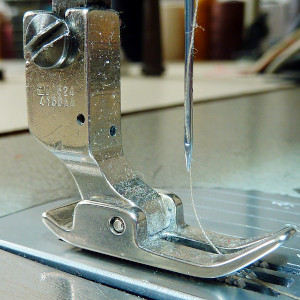The craft of using needle and thread dates back to time immemorial. This archaic art includes the stitching of fabrics, leather, and many other similar materials. With the invention of the sewing machine, the work of stitching became faster and has broadened its scope as well. However, when there is the involvement of machines with prearranged accessories, there is always a chance of wear and tear. Few quick tips must be known about how to fix a sewing machine as and when required.
How to fix a Sewing Machine?: General Complications
 Time and again, you might have come across a few instances when your sewing machine might have stopped working. Amidst a vital project or while giving a finishing touch in the outfit, when the sewing machine does not collaborate, nothing is baffling than this. One must be aware of the common issues that lead to a halt in the motion of the work while working with a sewing machine. Some of the familiar issues can be mentioned as under:
Time and again, you might have come across a few instances when your sewing machine might have stopped working. Amidst a vital project or while giving a finishing touch in the outfit, when the sewing machine does not collaborate, nothing is baffling than this. One must be aware of the common issues that lead to a halt in the motion of the work while working with a sewing machine. Some of the familiar issues can be mentioned as under:
Accumulation Of Threads
You may notice a few threads knotting up while sewing. This generally occurs at the lower side of the cloth of the fabric, which is being sewed. If pulled suddenly without identifying the exact issue, it might deteriorate the process of the machine and also the fabric.
Crooked Or Inclined Needles
Old needles that have been used a lot tend to become bent at the tip, this harms the fabric on which stitching is done. If the correct needle is not used for a particular type of fabric, the overall look of the garment or the textile will be hampered.
Displacement Of The Fabric
The sewing machine does not work correctly when the said fabric is not placed successfully. The machine also does not function properly, if the feed dogs that move in to and from movement come in contact with other embroidered areas.
Frequent Tear In The Thread
Threads are different while using a machine. When stitching is done by hand, various threads are used. If these are used in a machine while sewing, they tend to break easily. These threads cannot withstand the pressure that the sewing machine imparts in them.
Leaps In Stitches
Both incorrect needles and a bobbin may be the reason when there are leaps in stitches. Threads do not clasp properly if the upper thread does not reach the bobbin.
Inconsistency In The Bobbin
Examine the bobbin if there is a frequent need to alter the pressure of the thread attached to the bobbin. Bobbins made of plastics, easily become loose. Thus, the pressure is too tough to control.
Tangles In The Thread
The threads at the end tend to assemble at the end. This is caused mainly while stitching backward. Assembling of thread over the fabric does not give the required clear touch to the outfit.
Bizarre Noise In The Machine
Lack of proper maintenance of the machine leads to peculiar noises. Stop using the machine whenever there is any strange noise from it. This is also caused when frequent oiling is not done. The deficiency of oil in the machine increases friction, and the machine is harmed as a result.
Sewing Machine Maintenance Tips
 Different issues with the sewing machines can be amended in different ways. Some of which can be briefly explained as follows:
Different issues with the sewing machines can be amended in different ways. Some of which can be briefly explained as follows:
Proper Timing
Stitches can get skipped if either the hook or the needle does not enter at the appropriate time. There can also be an irregularity in the upper or lower loop, or the thread cannot form a loop at all. When such issues occur during sewing, adjust the tension of the thread. Apply proper pressure of the foot on the pedal. If not, change both thread and needle. Use new ones with appropriate settings and timings. It will ensure that the loop is formed at the required pace and point.
Correct Needle
A different kind of stitches requires different types of needles. Similar is the case with different fabrics. While sewing, check that the correct type of needle is used. The stylus must be straight. It should also be installed correctly. In most cases of leaped or skittered stitches, the issue is generally with the needle.
Switch Settings
At times, when the machine does not function at all, check the settings. The pedal might not be connected. The needle may not move if the winder of the bobbin is switched on. This leads the machine to shut down. Also, investigate the feed dogs when there is movement in the needle, but there is no proper cloth progress. Feed dogs are thorn-like structures that lie below the needle. While sewing, it helps in sliding the fabric forward. By mistake, if it had been turned off, turn it on to continue stitching.
Smooth Functioning
A few drops of machine oil can make the machine run smoothly. Keeping the machine clean is one of the essential tips for maintaining its longevity. Keep a check on the bobbin case. It generally accumulates the thread’s fragments, which, when cleaned by brushing off, shall again let the machine function smoothly.
 Deterioration Of Thread And Needle
Deterioration Of Thread And Needle
If there is any breakage in the needle and thread, ensure that it is not convoluted and is adjusted to the bobbin. Examine the size and type of bobbin while fitting the case. It will reduce the breakage of needle and thread.
Appropriate Placing
Ensure that the setting of the machine is appropriately adjusted while placing the fabric. Also, concentrate on the amount of pressure needed in the pedal. Incorrect pressure will not allow the fabric to be inserted appropriately.
Stitching Till The End
When stitching is at its end of the edge, ensure that the stitches are done till the seams. This will avoid the intertwining of the threads while backstitching.
How To Fix A Sewing Machine: Final Thoughts
These tips mentioned above shall help you to resolve the frequently occurring issues when working with a sewing machine. Regular maintenance shall assure that they do not break down at the eleventh hour. If some of the problems are persistent and cannot be solved with limited knowledge, consult a skilled technician. Try to identify the issues so that the solutions can come handy in the near future.



